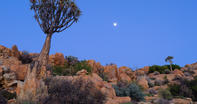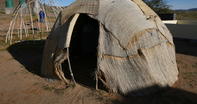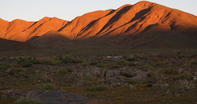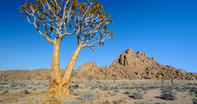Esoteric Beauty
The Richtersveld is a remote region; hot, dry and seemingly lifeless. It has a certain esoteric beauty, sure, but why should such a barren place be worthy of World Heritage status?

Well, according to the documents prepared by the nominating party, the site has both natural and cultural criteria that make it unique. In other words, there’s much more to the Richtersveld than first meets the eye. In terms of cultural significance, the Richtersveld is the home of the last remaining members of the Nama tribe of Khoikhoi who still practice their traditional semi-nomadic way of life.
This special form of ‘transhumance’ entails small family groups who move with their herds of sheep and goats from one seasonal grazing area to another. Significantly, some of them still live in their traditional dome shaped matjieshuise (reed huts), known as |haru oms in the Nama language. This unbroken cultural and architectural tradition stretches back over 2000 years.
Amazing Diversity

The natural criteria are equally impressive. Despite the low annual rainfall, several climatic conditions are present in the Richtersveld that allow an amazing diversity of botanical life to proliferate. 350 species are endemic to the region and it contains the world’s most diverse lichen fields (found near Alexander Bay).
Furthermore, the Richtersveld is part of the Succulent Karoo biome, which covers the western coastal regions of South Africa and southern Namibia. This wider region contains over 5000 plant species and around 40% of these are endemic, including many rare succulents, making it one of only two arid biodiversity hotspots in the world (the other is on the horn of Africa).
Nevertheless, it was the cultural significance of the Nama stock farmers and their ancient lifestyle that most impressed UNESCO and its investigating committee. In their report, they found that the site has a high degree of integrity and authenticity in this regard.
The traditional system of seasonal migration is still functional, the stockposts and |haru oms are being used as part of daily life, and the nomadic form of herding practised by the Nama is testimony to an ancient form of land management that has helped maintain the fragile Succulent Karoo ecosystem.
World Heritage List

In light of these findings, the Richtersveld Cultural and Botanical landscape was admitted onto the World Heritage list in terms of cultural criteria iv and v, viz.: (iv) to be an outstanding example of a type of building, architectural or technological ensemble or landscape which illustrates (a) significant stage(s) in human history. (v) to be an outstanding example of a traditional human settlement, land-use, or sea-use which is representative of a culture (or cultures), or human interaction with the environment especially when it has become vulnerable under the impact of irreversible change.
These have been interpreted by UNESCO as follows:
(iv) the rich diverse botanical landscape of the Richtersveld, shaped by the pastoral grazing of the Nama represents and demonstrates a way of life that persisted for many millennia over a considerable part of southern Africa and was a significant stage in the history of this area.
(v) the Richtersveld is one the few areas in southern Africa where transhumance pastoralism is still practised: as a cultural landscape [implying a significant interaction between humans and their physical environment] it reflects long-standing and persistent traditions of the Nama, the indigenous community. Their seasonal pastoral grazing regimes, which sustain the extensive bio-diversity of the area, were once much more widespread and are now vulnerable.
Integrity of the Site

As is indicated above, however, the integrity of the site is under threat. There are currently only around 300 individuals who still practice the traditional form of stock farming, and most of these people are elderly.
The area has also become overgrazed, mainly because private land ownership has encroached on the Nama over the last couple of hundred years and this has limited the wider migration patterns of the stock farmers. Mining activities along the Orange River and in the Richtersveld National Park are also potentially damaging, as this destroys both the physical environment and the cultural traditions of the Nama, who often leave their villages to work on the mines and in the nearby towns.
In view of this, the actual World Heritage site has been limited in size to what is called the Richtersveld Community Conservancy (RCC). This is an area of 160 000 hectares of grazing land, which is controlled by the Sida !hub Community Property Association (CPA).
To be more specific, the declared area is bounded in the north by the Vandersterr Mountains, and by the Orange River and Nababiep mountains in the East. To the South and West, the area is buffered by additional tracts of grazing land. At this stage, the spectacular Richtersveld National Park (located north of the Vandersterr Mountains) is excluded from the World Heritage site because there is still mining activity going on within the park’s boundaries.
There is a possibility, however, that World Heritage status will be extended to the park once the mines are shut down and the land has been rehabilitated. This may happen sooner rather than later because the mines are nearly exhausted, and there are already agreements in place which allow the Nama stock farmers to graze within the park’s boundaries.
By David Fleminger